Multiomics Tissue Spatial Technologies
PCR Real Time Systems
Cell Transfection
Nucleic Acid Analysis
Automation
Shared Equipment
Genomic Instrumentation
The LCA-Genome Services oversees several instruments available for use by members of the research community. As providers, we are responsible for facilitating equal access to these instruments and maintaining proper function and updates. Maintenance is performed at a regular schedule defined by the manufacturer. As users, you are responsible for following the guidelines issued by the Core. Please refer back to the information provided by the Core and be respectful to reserve on the iLab calendar prior to using an instrument.
** For questions related to genome services and instrumentation, please contact Emanuela Zacco at [email protected] **
XENIUM 10X Genomics

Xenium is A state-of-the-art single cell, high-resolution, imaging-based, spatial profiling technology from 10x Genomics that allows for simultaneous expression analysis of RNA targets (currently in range of 100's) within the same tissue section. Xenium Analyzer seamlessly integrates high-resolution imaging and onboard data analysis enabling the analysis of 400 mm2 of fresh frozen or FFPE tissues in <50 hrs.
Using the Xenium: Please contact core personnel at [email protected]to inquire about training, full service, and instrument reservation.
Location: HD335, Helen Diller Building, Mission Bay Campus
MagicPrep NGS
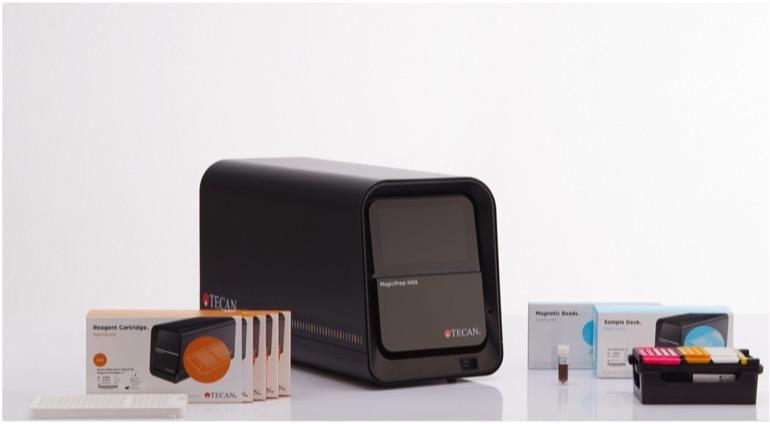
MagicPrep NGS system is a new category of automated laboratory equipment that provides push button simplicity for NGS library preparation for Illumina sequencing platforms for DNA and mRNA. The MagicPrep NGS system provides a complete solution that includes the instrument, software, pre-optimized scripts, reagents, and consumables.
Using the MagicPrep NGS: RPlease contact core personnel at [email protected]to inquire about training, full service, and instrument reservation.
Location: HD235, Helen Diller Building, Mission Bay Campus
Agilent Bioanalyzer 2100
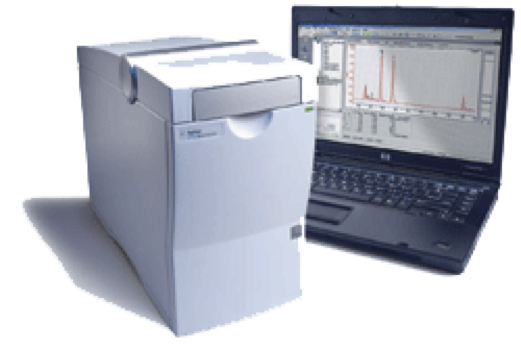 The Agilent Bioanalyzer 2100 is a microfluidics-based platform that combines the principles of electrophoresis and flow cytometry to allow quantitative and qualitative analysis of various sample types that include total RNA, mRNA, microRNA, small RNA, and small to large fragments of PCR amplified DNA or fragmented DNA.
The Agilent Bioanalyzer 2100 is a microfluidics-based platform that combines the principles of electrophoresis and flow cytometry to allow quantitative and qualitative analysis of various sample types that include total RNA, mRNA, microRNA, small RNA, and small to large fragments of PCR amplified DNA or fragmented DNA.
Using the Bioanalyzer: Reservations are made in iLab. Please contact core personnel at [email protected] if you need training on the platform.
Location: HD330, Helen Diller Building, Mission Bay Campus
Nanodrop 8000
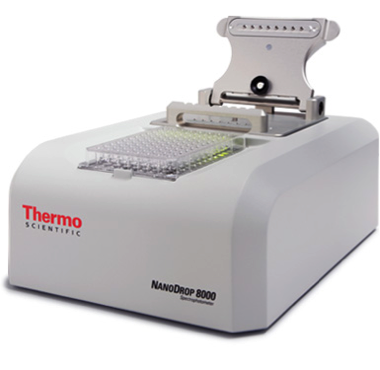 The Nanodrop 8000 is a multi-well (8 total) UV-Vis spectrophotometer used for absorbance detection within 220-750 nm, designed to be used for detecting nucleic acid concentration, proteins and labeling dye. Sample volume input is 1uL. Dynamic range for dsDNA is 2.5-3700 ng/uL, according to the manufacturer.
The Nanodrop 8000 is a multi-well (8 total) UV-Vis spectrophotometer used for absorbance detection within 220-750 nm, designed to be used for detecting nucleic acid concentration, proteins and labeling dye. Sample volume input is 1uL. Dynamic range for dsDNA is 2.5-3700 ng/uL, according to the manufacturer.
Using the Nanodrop 8000: Because the instrument is a shared resource of the building, reservation of the instrument is not needed. Please use the sign-in binder next to the Nanodrop, so we can track usage.
Location: S172, Cancer Research Building, Mount Zion Campus
Biotek Synergy (HT) Microplate Reader
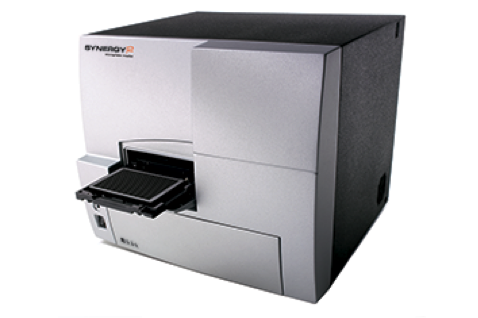 The Synergy (HT) Plate Reader with BioTek software is a multi-mode microplate spectrophotometer for fluorescence, absorbance and luminescence measurements on 96 and 384 well plates. Protocols are designed using the BioTek software to instruct commands for the instrument (shaking/mixing etc). Quantifications using standard curves may be done automatically using the software.
The Synergy (HT) Plate Reader with BioTek software is a multi-mode microplate spectrophotometer for fluorescence, absorbance and luminescence measurements on 96 and 384 well plates. Protocols are designed using the BioTek software to instruct commands for the instrument (shaking/mixing etc). Quantifications using standard curves may be done automatically using the software.
Using the Synergy Plate Reader: Only researchers located in the Cancer Research Building at the Mount Zion Campus may use the instrument. Because the instrument is a shared resource of the building, reservation of the instrument is not needed. Please use the sign-in binder next to the plate reader, so we can track usage.
Location: S176, Cancer Research Building, Mount Zion Campus
Eppendorf epMotion 5075
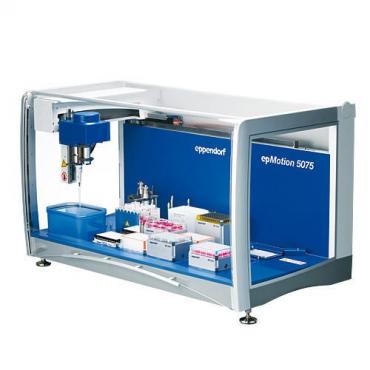 The recently upgraded EpMotion 5075 is an automated liquid handling system linked to a desktop computer software is designed for effective, automated liquid handling applications providing a precise, accurate alternative to time-consuming manual pipetting and liquid handling tasks. The combination of accelerated operational speed, new software & hardware features and an increased number of worktable positions make the systems ideal for simple and flexible laboratory use across a wide range of liquid handling applications. This is supported even further by an optical sensor that checks labware, liquid levels and tip counts and type at the start of each cycle, hugely decreasing any risk of error during the run.
The recently upgraded EpMotion 5075 is an automated liquid handling system linked to a desktop computer software is designed for effective, automated liquid handling applications providing a precise, accurate alternative to time-consuming manual pipetting and liquid handling tasks. The combination of accelerated operational speed, new software & hardware features and an increased number of worktable positions make the systems ideal for simple and flexible laboratory use across a wide range of liquid handling applications. This is supported even further by an optical sensor that checks labware, liquid levels and tip counts and type at the start of each cycle, hugely decreasing any risk of error during the run.
The instrument allows for single pipetting using 1uL, 10uL, 100uL, and 1000uL automated pipettors and multichannel pipetting using 50uL and 1000uL automated pipettors.
Possible applications: serial dilutions, real-time PCR set-up, immunoassay set-up, sample pooling, distributing reagents, magnetic beads DNA extractions, NGS-automated library preparation.
Using the epMotion 5075: Reservations are made in iLab. The LCA-Genome Core will work with you on programming the machine for your own application. Please contact the Genome Core at [email protected] for more information.
Location: HD330 Helen Diller Building, Mission Bay Campus
QuantStudio 5 qPCR System
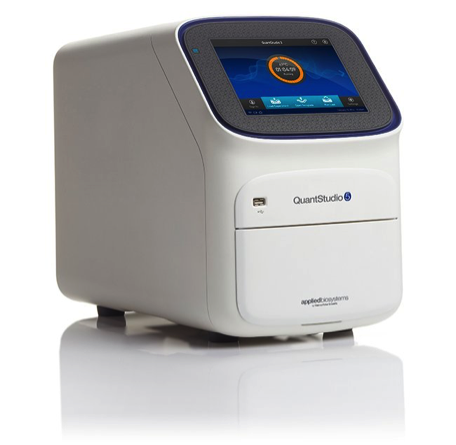
The Applied Biosystems QuantStudio 5 Real-Time PCR System with 384-well block is a real-time thermocycler that allows quantitative and qualitative detection of nucleic acids based on fluorescent-based technology. The optimized Design and Analysis software is ideal for both first-time and experienced users. The instrument includes wi-fi connectivity and when connected to the Thermo Fisher Cloud, the QuantStudio 5 system provides access to your data wherever and whenever you want. The 384-well format has 5 excitation filters (450-650nm) and 5 emission filters (500-700nm).
QuantStudio 5 has a HRM curve capabilities; a relatively new, post-PCR analysis method used to identify variations in nucleic acid sequences. The method is based on detecting small differences in PCR melting (dissociation) curves. It is enabled by improved dsDNA-binding dyes used in conjunction with real-time PCR instrumentation that has precise temperature ramp control and advanced data capture capabilities. Data are analyzed and manipulated using software designed specifically for HRM analysis. For HRM application mutation scanning and methylation analysis information please see the following links.
Data storage and analysis with QuantStudio 5: Sign up here to the Thermo fisher cloud for secure, cloud-based data storage, scientific analysis apps and peer collaboration tools. Software available: qPCR Design and Analysis, High Resolution Melt Analysis (HRM), Standard Curve, Presence Absence Analysis, Relative Quantification, Standard Curve.
Using the QuantStudio 5: Reservations are made in iLab following the standardized times for SYBR and Taqman, 3 hours and 2 hours per plate, respectively. Please plan your projects accordingly. New users must have a short training with the Core personnel before have access to the machine. Please contact the Genome Core at [email protected] for training. Please check the new cancellation policy)
Location: HD235, Helen Diller Building, Mission Bay Campus
Location: S171, Cancer Research Building, Mt Zion Campus
Lonza 4D-Nucleofector System
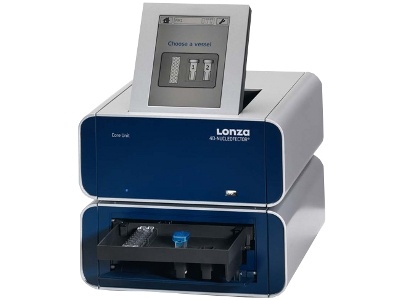 The 4D-Nucleofector System is the most advanced Nucleofection Platform offering maximum flexibility in regards to cell numbers, throughput, and cell status. The Nucleofector Technology is a highly efficient non-viral transfection method which is based on the momentary creation of small pores in cell membranes by applying an electrical pulse. The comprehensive way in which Nucleofector Programs and cell-type specific solutions are developed enables nucleic acid substrate delivery not only to the cytoplasm, but also through the nuclear membrane and into the nucleus. This allows for high transfection efficiencies up to 99% and makes the transfection success independent from cell proliferation.
The 4D-Nucleofector System is the most advanced Nucleofection Platform offering maximum flexibility in regards to cell numbers, throughput, and cell status. The Nucleofector Technology is a highly efficient non-viral transfection method which is based on the momentary creation of small pores in cell membranes by applying an electrical pulse. The comprehensive way in which Nucleofector Programs and cell-type specific solutions are developed enables nucleic acid substrate delivery not only to the cytoplasm, but also through the nuclear membrane and into the nucleus. This allows for high transfection efficiencies up to 99% and makes the transfection success independent from cell proliferation.
Using the 4D-Nucleofector: Reservations are made in iLab. Please contact the Genome Core at [email protected] regarding the use of this instrument.
Location: HD327, Helen Diller Building, Mission Bay Campus
Bioline Mic Magnetic Induction qPCR Cycler
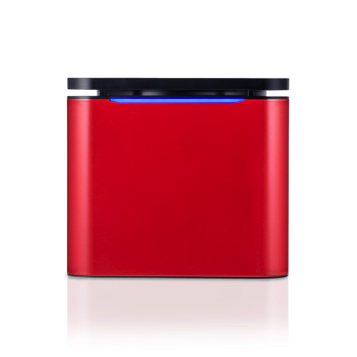 The Bioline Mic is a very fast, user-friendly, and low-throughput magnetic induction qPCR Cycler with a maximum of up to 48 samples per run. Mic uses a magnetic induction technology to heat samples and fan forced air for cooling. This means fast qPCR results in less than 25 minutes for 35 cycles.
The Bioline Mic is a very fast, user-friendly, and low-throughput magnetic induction qPCR Cycler with a maximum of up to 48 samples per run. Mic uses a magnetic induction technology to heat samples and fan forced air for cooling. This means fast qPCR results in less than 25 minutes for 35 cycles.
Using the Bioline Mic: Reservations are made in iLab. Please contact the Genome Core at [email protected] regarding use of this instrument.
Location: HD235, Helen Diller Building, Mission Bay Campus
Neon Electroporator
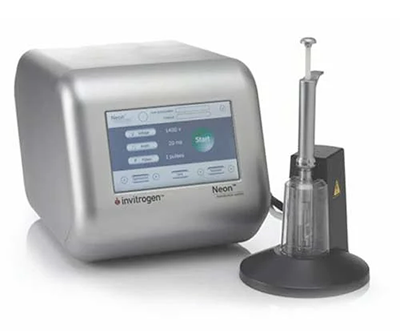 The Neon Transfection System offers an innovative electroporation transfection method that utilizes a proprietary biologically compatible pipette tip chamber to generate a more uniform electric field for a significant increase in transfection efficiency and cell viability. Over 140 cell types have been successfully transfected with the Neon Transfection System. Up to up to 90% transfection and gene-editing efficiency in in extremely difficult cells, including immune, primary and stem cells.
The Neon Transfection System offers an innovative electroporation transfection method that utilizes a proprietary biologically compatible pipette tip chamber to generate a more uniform electric field for a significant increase in transfection efficiency and cell viability. Over 140 cell types have been successfully transfected with the Neon Transfection System. Up to up to 90% transfection and gene-editing efficiency in in extremely difficult cells, including immune, primary and stem cells.
Using the Neon System: The system is free to use for the UCSF community, please reserve it in iLab.
Location: HD337, Helen Diller Building, Mission Bay Campus
Digital Spatial Profiling GeoMx, Nanostrings Technologies
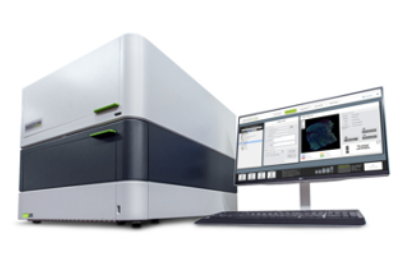
Spatially profile the whole transcriptome and 570+ protein targets separately or simultaneously from your choice of sample inputs: whole tissue sections, tissue microarrays (TMAs), or organoids.
Non-destructive, highly multiplexed, multi-omics technology that quantifies target proteins and transcripts in spatially defined areas of a microscopy slide. Thus, it allows cell type-specific analysis of frozen, paraffin embedded and FFPE tissues. The GeoMxTM detects target proteins or RNA species using antibodies or hybridization probes, respectively, that are conjugated to indexing oligos. These oligos are conjugated by a UV-cleavable linker, and they are released from the slide by highly localized digital UV illumination. This step imparts spatial information for each sample. The released oligos are collected from an aqueous layer above the tissue slice over each region of interest (ROI) by automated capillary pipette and then transferred into microwells for index counting. This last step can utilize either Nanostring nCounter technology or NGS, which allows a nearly limitless degree of multiplexing. Note that the original tissue is not destroyed, because the UV-cleaved index oligos are recovered while the original proteins and RNAs remain in place.
Using the Nanostring GeoMx: Please contact the LCA-genome Core personnel regarding the use of this system at [email protected]. Full service will also be available.
Location: HD335, Helen Diller Building, Mission Bay Campus
Nanostring nCounter Spring
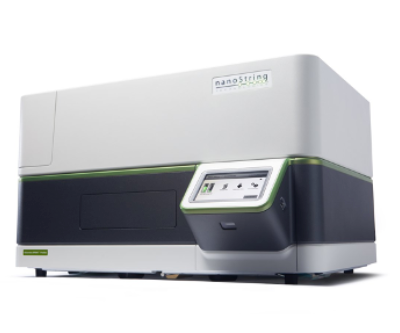 The nCounter® platform provides a simple and cost-effective solution for multiplex analysis of up to 800 RNA, DNA, or protein targets. Nanostring’s nCounter technology is based on direct detection of target molecules using color-coded molecular barcodes, providing a digital count of the number of target molecules. nCounter’s digital counting capability provides highly reproducible data over 5 logs of dynamic range and does not require any amplification steps that might introduce bias to the results. An additional advantage of nCounter chemistry is that it is highly tolerant of difficult sample types such as FFPE and crude-cell lysates.
The nCounter® platform provides a simple and cost-effective solution for multiplex analysis of up to 800 RNA, DNA, or protein targets. Nanostring’s nCounter technology is based on direct detection of target molecules using color-coded molecular barcodes, providing a digital count of the number of target molecules. nCounter’s digital counting capability provides highly reproducible data over 5 logs of dynamic range and does not require any amplification steps that might introduce bias to the results. An additional advantage of nCounter chemistry is that it is highly tolerant of difficult sample types such as FFPE and crude-cell lysates.
Using the nCounter System: Please contact the LCA-genome Core personnel regarding the use of this system at [email protected]. Full service will also be available.
Location: HD337, Helen Diller Building, Mission Bay Campus